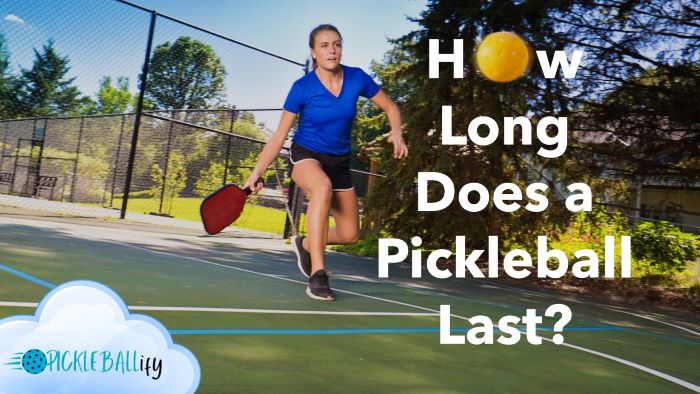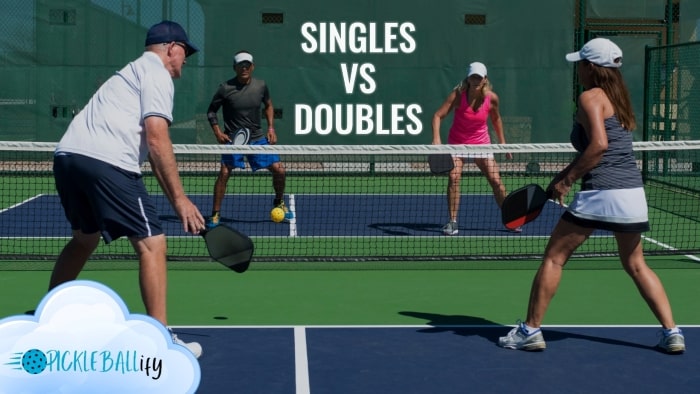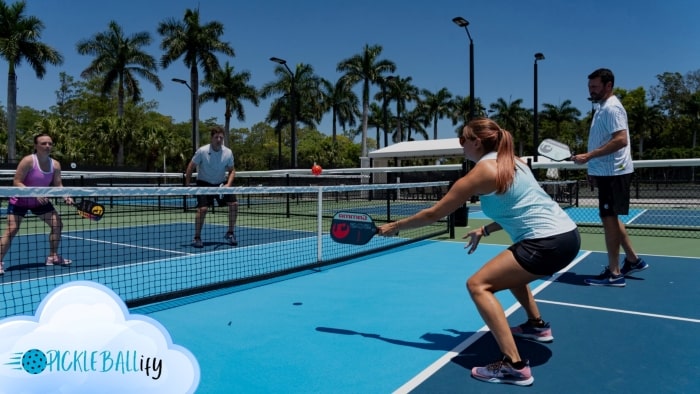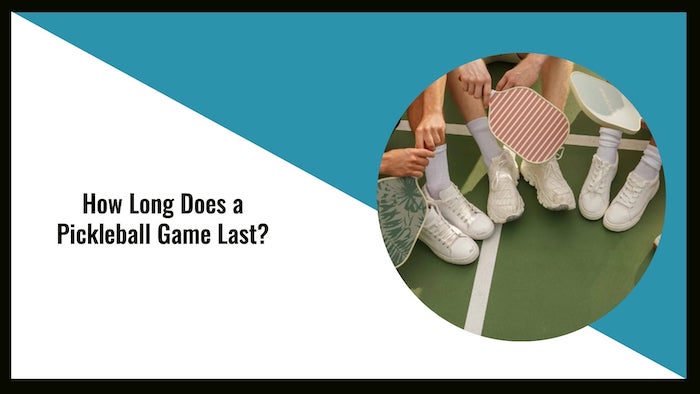Pickleball is a fast-paced and exciting sport that is rapidly gaining popularity among people of all ages. One of the first questions you may have as a newcomer to the game is, “How long does a pickleball game last?”
While the answer may appear simple, there are several factors that can influence the length of a pickleball game, including the skill level of the players and the type of game being played.
In this article, we’ll go over the specifics of pickleball game length, as well as the various other factors that affect the duration of the game and tips for effectively managing game time. So, if you’re interested in learning more about pickleball and how long a typical game lasts, let’s get started!

How Long Does a Pickleball Game Last?
A single game of pickleball typically lasts for 15 to 25 minutes. The game is played until one player or team reaches 11 points, with a margin of at least two points. This means that the game is not over until one side has a lead of two points over the other.
For example, if the score is 10-10, the game continues until one side scores 12 points or more. However, some games may go longer if the teams are evenly matched or if there are many faults or rallies. There are many types of faults in pickleball.
According to PickleballAus ” A game lasting 15 minutes includes a great deal of laughter, and social connectedness both on the court and off.”
- Hitting the ball out of bounds: The ball must land within the boundaries of the court on each hit. If it lands outside the court lines or on the line itself, it is considered out and a fault.
- Hitting the ball into the net: The ball must clear the net on each hit. If it touches the net or falls below it, it is a fault.
- Hitting the ball into the non-volley zone before it bounces: The non-volley zone (also known as the kitchen) is the area 7 feet from the net on both sides of the court. Players are not allowed to hit the ball in the air (volley) while standing in or touching this zone unless the ball has bounced first. If they do, it is a fault.
A rally is a sequence of hits between players without any faults. Rallies can vary in length depending on the skill and strategy of the players. Some players may try to end rallies quickly by hitting aggressive shots that are hard to return. Other players may try to extend rallies by hitting defensive shots that keep the ball in play.
Singles vs Doubles: Which One Takes Longer?
The number of players in a game does not affect its duration significantly. Pickleball can be played as singles (one-on-one) or doubles (two-on-two). Singles games may be faster or slower than doubles games depending on the skill level and style of play of each player.
For example, a singles game may be faster if one player is much better than the other and scores quickly. However, a singles game may also be slower if both players are equally skilled and have long rallies.

Doubles games may involve more teamwork and communication but also more defense and coordination. For example, a doubles game may be slower if both teams are good at covering the court and preventing easy points.
However, a doubles game may also be faster if one team has poor chemistry or makes more mistakes. Therefore, the length of a singles or doubles game depends more on the individual players and teams than on the number of players.
What Other Factors Affect How Long a Pickleball Game Lasts?
Some other factors that may influence how long a pickleball game lasts are:
1) The environment: Indoor games may be shorter than outdoor games due to weather conditions, distractions, or court size. For example, indoor games may be faster because there is no wind, sun, rain, or noise that can affect the players or the ball.
Outdoor games may be slower because these factors can make the game more challenging or unpredictable. Also, indoor courts may be smaller than outdoor courts, which can make the game faster or slower depending on the players’ preferences.
2) The equipment: Different types of paddles and balls may affect how fast or slow the game is played. For example, wooden paddles may be heavier and slower than composite paddles, which can affect the speed and power of the shots.
Plastic balls may be lighter and faster than rubber balls, which can affect the bounce and spin of the ball. Players may choose different types of equipment based on their skill level and style of play.
3) The rules: Some tournaments or leagues may have different rules for scoring, serving, timeouts, etc. that may change how long a game lasts. For example, some tournaments may use rally scoring where every point counts regardless of who serves, while others may use traditional scoring where only the serving team can score.
4) The purpose: Some players may play for fun, exercise, socialize, or competition. These different motivations may affect how seriously they play and how long they want to play. For example, some players may play casually and enjoy longer games with more rallies and conversations, while others may play competitively and prefer shorter games with more points and intensity.
Tips for Managing Game Time Effectively
Managing game time effectively is an important skill for pickleball players who want to win more games and matches. Game time management involves knowing how to use your time wisely during each point, game, and match.

Here are some tips for managing game time effectively:
Use Your Serve and Return of Serve Wisely
The serve and return of serve are the first two shots of each point, and they can set the tone for the rest of the rally. You want to use these shots to gain an advantage over your opponent by hitting them deep, low, and with good placement. Avoid hitting weak or short serves or returns that give your opponent an easy opportunity to attack.
Move Quickly to the Non-Volley Zone
The non-volley zone (also known as the kitchen) is the area 7 feet from the net on both sides of the court. It is where most of the action happens in pickleball, as players try to hit soft shots (dinks) over the net and into their opponent’s non-volley zone.
You want to move quickly to the non-volley zone after your serve or return, so you can be ready to dink or volley with your opponent. Moving quickly also saves you time and energy, as you don’t have to cover as much ground on the court.
Control the Pace of Play
Controlling the pace of play entails choosing whether to play a fast or slow game. You may prefer one pace over another depending on your skill level, style of play, and opponent’s strengths and weaknesses. If you’re good at hitting hard shots (drives) and smashes, you might want to play a fast game that puts pressure on your opponent.
If you can hit soft shots (drops) and dinks, you should play a slow game that forces your opponent to make mistakes or lose patience. You can control the pace of play by varying your shots with different angles, pace, and spin, as well as by choosing when to hit hard or soft shots.
Use Timeouts Strategically
Timeouts are breaks in play that allow players to rest, recover, regroup, or change their strategy. Each player or team has two timeouts per game, and one timeout per match (if playing best two out of three games). A timeout lasts for one minute.
You can use timeouts strategically when you need to stop your opponent’s momentum when you need to adjust your game plan, when you need to calm down or refocus yourself, or when you need to deal with an injury or equipment issue.
FAQs
Playing indoors or outdoors can have some impact on the length of a pickleball game. Outdoor games may be affected by weather conditions, such as heat, cold, wind, or rain3. Indoor games may have fewer distractions and more consistent lighting and temperature. However, these factors may not make a significant difference in most cases.
If you want to reduce the length of your pickleball games, play with more skilled players who can score points faster and make fewer errors. You can also play with smaller margins of victory, such as winning by one point rather than two. If you want to extend your pickleball games, play with less skilled players who can extend rallies and make more errors.
A tournament of pickleball can last much longer than a single game or match. A tournament usually involves multiple rounds of matches between different players or teams. Depending on the number and format of matches, a tournament can last from several hours to several days. Some tournaments may also have different scoring systems, such as playing to 15 or 21 points instead of 11.
A game of pickleball is won by the first player or team to reach 11 points, with a margin of at least two points. For example, if the score is 10-10, the game continues until one side has a two-point lead, such as 12-10 or 13-11.
Well, It’s a Wrap
To summarise, the duration of a pickleball game can vary depending on a variety of factors such as the skill level of the players, the scoring system used, and the pace of the game. Pickleball games typically last 15 to 45 minutes, with matches consisting of several games or sets.
However, it is important to note that the rules and formats used in pickleball vary widely, which can affect the length of a game.
Finally, understanding the specific rules being used and playing the game with a group of like-minded players who are interested in having fun and enjoying the sport. It is the best way to determine the length of a pickleball game.

